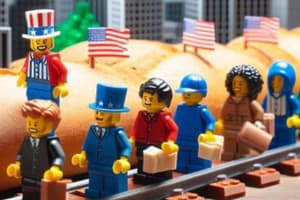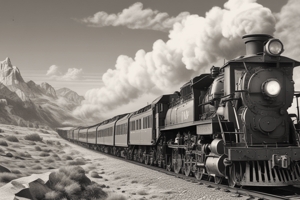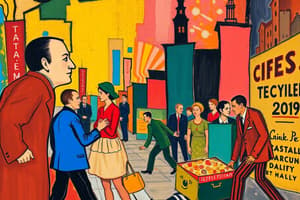Podcast
Questions and Answers
What was the main consequence of banks ceasing to buy shares on October 28th?
What was the main consequence of banks ceasing to buy shares on October 28th?
- Stabilization of share prices
- Increase in investor confidence
- Panic selling intensified (correct)
- Record low trading volumes
What notable event occurred on Black Tuesday, October 29th?
What notable event occurred on Black Tuesday, October 29th?
- Heavy buying activity by investors
- Price stabilization following a sell-off
- 16.4 million shares traded with no buyers (correct)
- A government intervention announcement
Which event occurred the day after Black Thursday, October 25th?
Which event occurred the day after Black Thursday, October 25th?
- Only 3.5 million shares traded
- President Hoover's address about the market (correct)
- Banks actively buying shares
- A significant rise in stock prices
How many shares were traded on the day described as Black Thursday?
How many shares were traded on the day described as Black Thursday?
What was a reaction to falling share prices on October 23rd?
What was a reaction to falling share prices on October 23rd?
What was the primary reason US companies faced declining profits in the late 1920s?
What was the primary reason US companies faced declining profits in the late 1920s?
What does 'Buying on Margin' refer to?
What does 'Buying on Margin' refer to?
What triggered the panic selling of shares in September 1929?
What triggered the panic selling of shares in September 1929?
How did speculators exacerbate the banking crisis?
How did speculators exacerbate the banking crisis?
What action did the six major banks decide to take on 25 October?
What action did the six major banks decide to take on 25 October?
What was the effect of the panic selling on October 29, 1929?
What was the effect of the panic selling on October 29, 1929?
Around how many banks closed each year during the 1920s?
Around how many banks closed each year during the 1920s?
What was one reason speculators became increasingly nervous in the late 1920s?
What was one reason speculators became increasingly nervous in the late 1920s?
What economic issue contributed significantly to the Wall Street Crash of 1929?
What economic issue contributed significantly to the Wall Street Crash of 1929?
How did the wealth gap affect consumer spending in the 1920s?
How did the wealth gap affect consumer spending in the 1920s?
What role did overproduction play in the lead-up to the Wall Street Crash?
What role did overproduction play in the lead-up to the Wall Street Crash?
Which government policy exacerbated the issues faced by American farmers in the 1920s?
Which government policy exacerbated the issues faced by American farmers in the 1920s?
What effect did falling company profits have on the workforce?
What effect did falling company profits have on the workforce?
What technology significantly increased the production capabilities of US industries in the 1920s?
What technology significantly increased the production capabilities of US industries in the 1920s?
Which factor created competition for American farmers during the late 1920s?
Which factor created competition for American farmers during the late 1920s?
How did tariffs affect the ability of American industries to sell products overseas?
How did tariffs affect the ability of American industries to sell products overseas?
What was one of the primary reasons for the downturn in the economy at the end of the 1920s?
What was one of the primary reasons for the downturn in the economy at the end of the 1920s?
What economic policy did the Republican Party support during the 1920s?
What economic policy did the Republican Party support during the 1920s?
How did speculators typically finance their stock purchases in the 1920s?
How did speculators typically finance their stock purchases in the 1920s?
What happened in October 1929 that triggered a loss of confidence in the stock market?
What happened in October 1929 that triggered a loss of confidence in the stock market?
Which issue contributed to the financial instability of small rural banks in the 1920s?
Which issue contributed to the financial instability of small rural banks in the 1920s?
What event occurred on October 24, 1929, that marked a significant point in the stock market crash?
What event occurred on October 24, 1929, that marked a significant point in the stock market crash?
In 1929, how much money did banks lend to speculators?
In 1929, how much money did banks lend to speculators?
What was the belief that drove speculation in the stock market during the 1920s?
What was the belief that drove speculation in the stock market during the 1920s?
What was a major sign of the economic troubles in 1929 before the Wall Street Crash?
What was a major sign of the economic troubles in 1929 before the Wall Street Crash?
How did banks contribute to the speculative behavior before the stock market crash?
How did banks contribute to the speculative behavior before the stock market crash?
What effect did the rush to buy shares in 1928 have on share prices?
What effect did the rush to buy shares in 1928 have on share prices?
What was a significant consequence of speculators failing to pay back their loans?
What was a significant consequence of speculators failing to pay back their loans?
What was the outcome for depositors if a small rural bank collapsed during the 1920s?
What was the outcome for depositors if a small rural bank collapsed during the 1920s?
What demographic change occurred from 1920 to 1929 regarding stock ownership?
What demographic change occurred from 1920 to 1929 regarding stock ownership?
What happened to share prices after the Babson Break in September 1929?
What happened to share prices after the Babson Break in September 1929?
What was the approximate number of banks operating in the USA during the 1920s?
What was the approximate number of banks operating in the USA during the 1920s?
Flashcards
Wealth Gap
Wealth Gap
Unequal distribution of wealth, where a small percentage of the population holds a large portion of the wealth while the majority struggles financially.
Overproduction
Overproduction
Producing more goods or services than the market can absorb, leading to surplus and falling prices.
Saturated Market
Saturated Market
A situation where consumers have already purchased all the goods or services they need, leading to decreased demand.
Tariffs
Tariffs
Signup and view all the flashcards
Hawley-Smoot Tariff Act
Hawley-Smoot Tariff Act
Signup and view all the flashcards
How did rising tariffs contribute to the Wall Street Crash?
How did rising tariffs contribute to the Wall Street Crash?
Signup and view all the flashcards
How did overproduction by US industries contribute to the Wall Street Crash?
How did overproduction by US industries contribute to the Wall Street Crash?
Signup and view all the flashcards
How did the wealth gap contribute to the Wall Street Crash?
How did the wealth gap contribute to the Wall Street Crash?
Signup and view all the flashcards
Buying on Margin
Buying on Margin
Signup and view all the flashcards
Speculation in the 1920s
Speculation in the 1920s
Signup and view all the flashcards
Impact of Speculation on the Crash
Impact of Speculation on the Crash
Signup and view all the flashcards
What were signs of a weakening economy in the 1920s?
What were signs of a weakening economy in the 1920s?
Signup and view all the flashcards
Role of Banks in the Crash
Role of Banks in the Crash
Signup and view all the flashcards
Loss of Confidence in 1929
Loss of Confidence in 1929
Signup and view all the flashcards
Speculators
Speculators
Signup and view all the flashcards
Panic Selling
Panic Selling
Signup and view all the flashcards
How did US companies get hurt in the 1920s?
How did US companies get hurt in the 1920s?
Signup and view all the flashcards
What happened to speculators during the 1929 crash?
What happened to speculators during the 1929 crash?
Signup and view all the flashcards
What role did banks play in the 1929 crash?
What role did banks play in the 1929 crash?
Signup and view all the flashcards
Why did speculators become nervous in the late 1920s?
Why did speculators become nervous in the late 1920s?
Signup and view all the flashcards
What did major banks do to try to stop the crash?
What did major banks do to try to stop the crash?
Signup and view all the flashcards
Black Thursday
Black Thursday
Signup and view all the flashcards
Black Tuesday
Black Tuesday
Signup and view all the flashcards
Why did banks stop buying shares?
Why did banks stop buying shares?
Signup and view all the flashcards
Speculators' Role
Speculators' Role
Signup and view all the flashcards
Laissez-faire Economics
Laissez-faire Economics
Signup and view all the flashcards
Liquidity in Banking
Liquidity in Banking
Signup and view all the flashcards
Speculation in the Stock Market
Speculation in the Stock Market
Signup and view all the flashcards
What was the main cause of the Wall Street Crash?
What was the main cause of the Wall Street Crash?
Signup and view all the flashcards
What was the role of banks in the Wall Street Crash?
What was the role of banks in the Wall Street Crash?
Signup and view all the flashcards
What were the early warning signs of the Wall Street Crash?
What were the early warning signs of the Wall Street Crash?
Signup and view all the flashcards
What triggered the panic selling on Black Thursday?
What triggered the panic selling on Black Thursday?
Signup and view all the flashcards
Study Notes
Underlying Weaknesses of the US Economy (1920s) and the Wall Street Crash
- Wealth Gap: In 1925, nearly 42% of the population lived below the poverty line with an annual income of less than $2000. This meant many couldn't afford basic necessities.
- Overproduction: Industrial mass production and new management techniques (Taylorism) led to a surplus of goods, creating a saturated market. Sales dropped, thus profits and share prices.
- Farmers' Overproduction: Farmers used new technologies (e.g. combine harvesters) to produce more crops. This, combined with tariffs that restricted exports, and competition from other countries, depressed farming profits.
- Lack of Export Markets: US industries faced tariffs from other countries, which limited their ability to sell products abroad. This resulted in a saturated domestic market, leading to decreased sales and falling profits, which lead to a decline in share values.
Studying That Suits You
Use AI to generate personalized quizzes and flashcards to suit your learning preferences.




